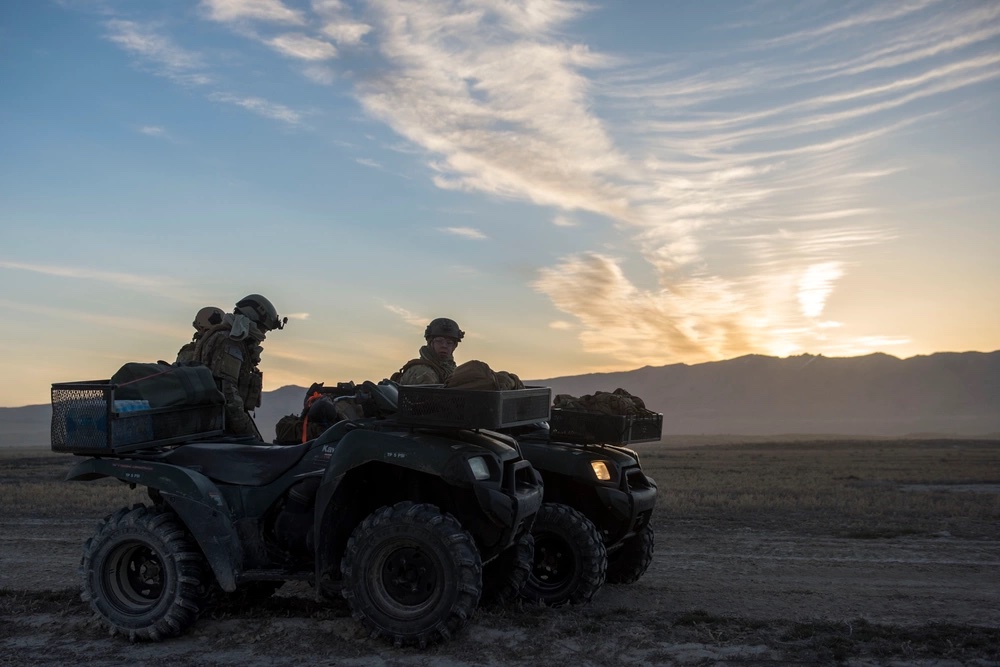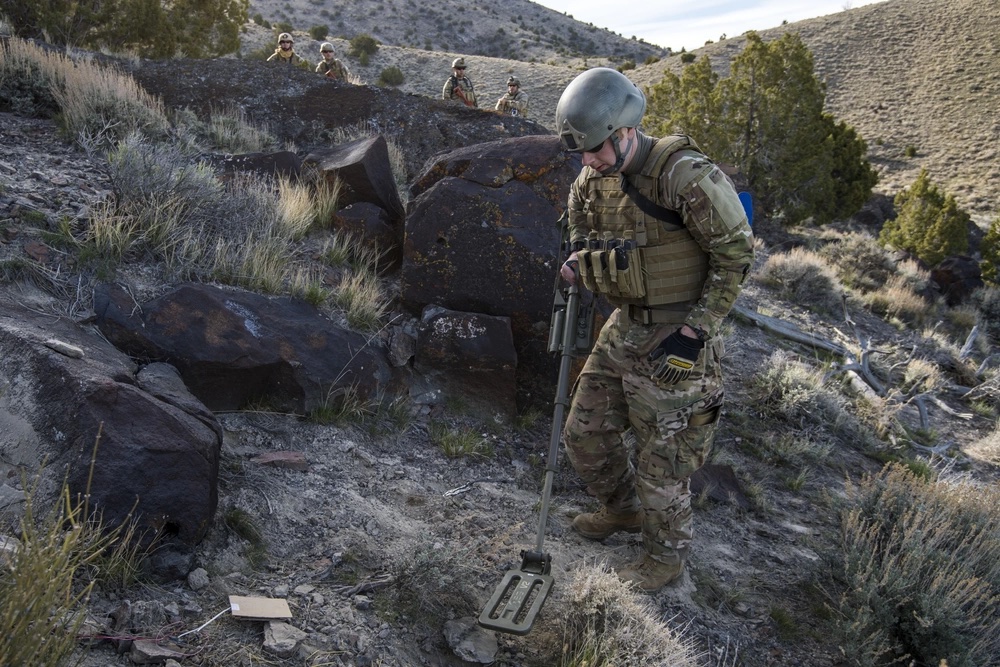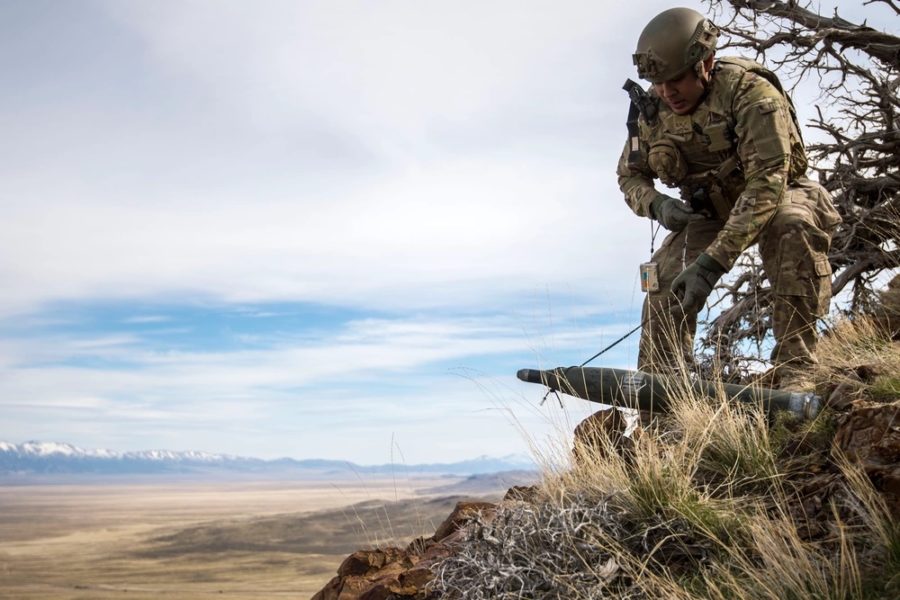HILL AIR FORCE BASE, Utah—Cleaning trash off a training range may sound like a dull task—but not if the trash is highly explosive.
Airmen with the 775th Explosive Ordnance Disposal (EOD) Flight deal with such trash on a regular basis at the Utah Test and Training Range (UTTR), an area about the size of Delaware where military aircraft practice dropping a wide range of ordnance. In the hands of an EOD technician, a dud bomb can become a useful tool to understand explosives and practice new disarming techniques that can help both the 775th and other units across the military.
“It builds an Airman’s understanding of explosives, and explosive effects, which trickles down to everything else that you’re going to do,” Staff Sgt. Cody Patterson, a member of the 775th, told Air & Space Forces Magazine. “I can’t mitigate a hazard if I don’t fully understand what the hazard is.”
One of the world’s largest weapon test facilities, UTTR has several kinds of ranges. Some are used year-round by military pilots honing their airstrike skills, while others are used to test new weapons being developed. On the large training ranges, the 775th EOD flight performs two large sweeps a year for unexploded ordnance, and they also clear out specific paths when range employees need to change or upgrade a target. The smaller test ranges need to be cleared more often so scientists and engineers can safely collect data on weapons performance.
“EOD is on the range if there is a used target, and somebody wants to go down there,” said Capt. James Stapleton, an element leader at the 775th. “For the test range, EOD clears the area so that the engineers can go do their part.”

The range work adds up: Patterson estimated that last year the 775th disarmed about 2,400 unexploded bombs, missiles, and more across 40 missions that could span from a couple of days to a couple of weeks depending on the size of the range being cleared. Maintaining vehicles for transport and preparing the logistics of range work is half the battle, he said.
“It all costs money and man-hours to upkeep equipment, vehicles, and trailers that we take to the range,” the sergeant said. “I would say easily 70 percent of our time is either on range or preparing to get to the range.”
One of the most hazardous tasks the 775th performs on the range is clearing areas where submunitions have been dropped. Hundreds of smaller submunitions can be dropped in one bombing run, and some submunitions have a dud rate of 10 to 15 percent. That means if 200 submunitions are dropped on a target, there may be 20 or more that hit the ground and do not detonate.
To clear out submunitions, up to a dozen EOD techs from the 775th ride on all-terrain vehicles, form a line with the team leader in the center of it, and then move across the target area scanning for unexploded ordnance, said bomb tech Senior Airman Brandon Hughes. If an EOD sees something suspicious, the line stops to inspect the object and, if it is not immediately hazardous, they mark the grid coordinates with their GPS-equipped ATAK phones and continue the process for the rest of the target area.
Once the area is swept, the team typically places charges near the ordnance and detonates them from a safe distance. Since they involve live explosives, every range mission is still a dangerous mission for the EOD techs—it is not just their lives on the line, but also those of range workers, scientists, and fellow service members who train there. Hughes said Army soldiers sometimes practice maneuvers on the same areas where aircraft drop bombs, though not at the same time.
“It is especially important for us to pay attention to those areas so they’re not running into any [unexploded ordnance] while they practice their soldiering skills,” he said.

Once they are detected, dud bombs offer EOD techs a chance to hone their craft.
“Everything can be a training event, essentially,” Patterson said. “Obviously we’re going to make it safe at all times. But you can try something like ‘hey, the [technical publication] says this is untested, but maybe I can gather some data.’”
For example, the 775th recently tested improvised methods of knocking the fuze off of a bomb, essentially disarming it. When the units discovers new tactics, techniques or procedures (TTPs), they pass them off to fellow bomb techs in the Army, Navy, and Marine Corps.
“As a career field we try to experiment and share with each other so we’re not keeping TTPs to ourselves,” Hughes said.
There is always room to learn something new, since no two range missions are alike.
“You’re never going to go to the same area and find the same 81mm mortar that you found the last time you were out there, so you always keep your head on a swivel trying to make sure you find everything that you need to find,” Hughes said.
The lessons learned at UTTR, particularly in regards to clearing submunitions, may play a key role in a possible near-peer conflict. During the Global War on Terror, troops often had to secure a city block against ground attack so that bomb techs could safely defuse a single improvised explosive device. In the future, Air Force EOD techs may have to clear isolated runways of large numbers of air-dropped unexploded ordnance as quickly as possible before another air attack arrives.
“We’re worried about ‘how do I clear this runway fast using the least amount of stuff,’ because it’s going to happen again,” said Patterson.
Some of those techniques harken back to “old-school World War II tactics” such as using rope, tape, and zip ties to yank submunitions off a runway all at once, he explained. Others include pouring concrete into a backhoe bucket and pushing the bombs off the tarmac, or using rope, tape, and a wrench to pull the fuze off from a distance.
“I can try something here so that later if I’m downrange and I’m trying to clear a runway, I already know what is or is not going to work because I just cleared a grid of 160 of these two months ago,” Patterson said.
Other explosives also have the benefit of being fun to detonate. Master Sgt. Rebecca Kimberling, another EOD tech, said illumination rounds or flares and chaff make sparkles like fireworks when they are blown up into the air. But one kind of explosion happens only at UTTR: destroying old or obsolete rocket motors that are used to propel nuclear missiles. Those detonations can involve 20,000 to 30,000 pounds of net explosive weight, Hughes said. By comparison, the biggest explosions EOD techs typically encounter in training is 1,000 pounds. The rocket motor detonations are “monumentally bigger,” he said.
“One of the neat things when you have an explosion that large is watching the blast wave just propagate outwards,” Kimberling said. “It just sends everything outwards, and it is such a fast process but it seems slow-mo when you’re watching it, like time is standing still for you.”
It just goes to show: Cleaning up the trash can be a real blast.


